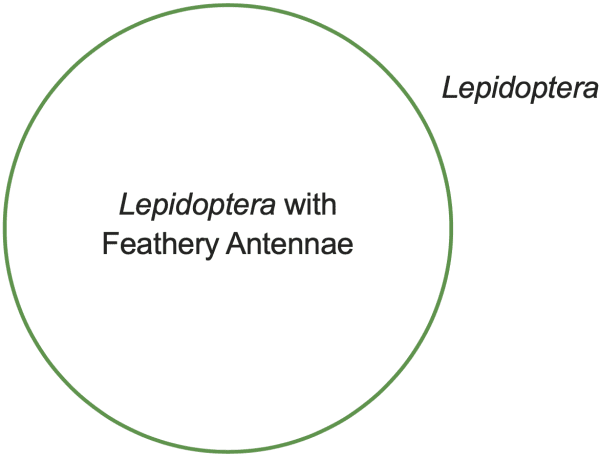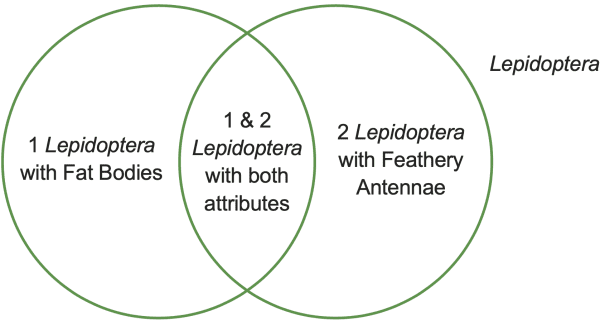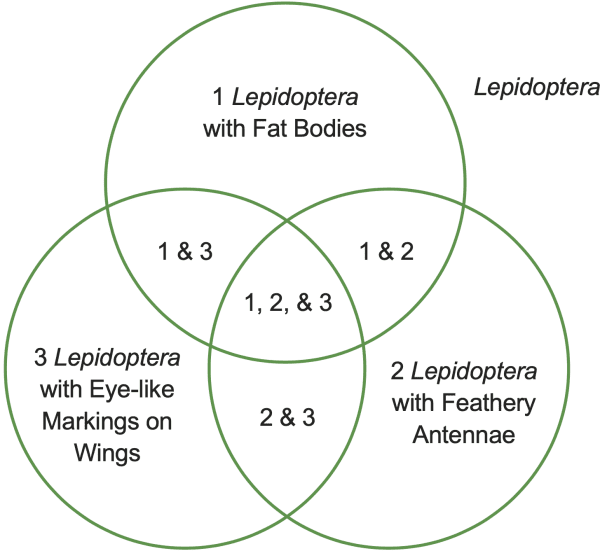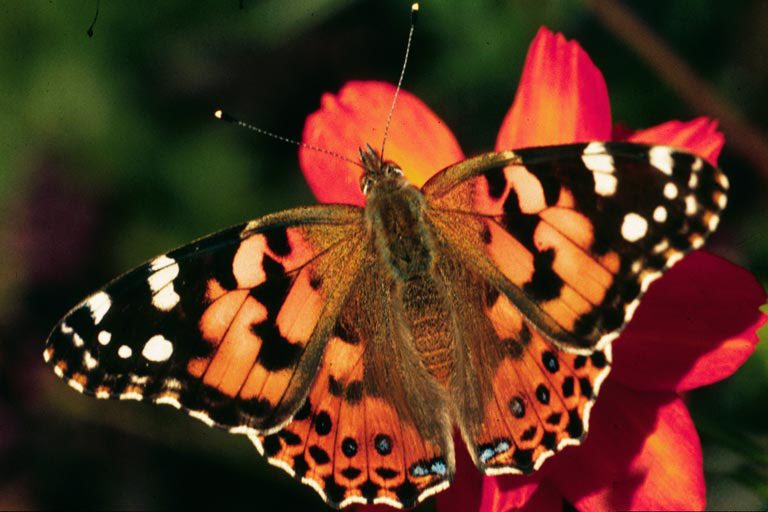Alabama 4-H

Use your observation skills as you distinguish butterflies from moths based on their characteristics.
Objectives
Youth will (1) learn that butterflies and moths are both members of the order of insects called Lepidoptera, (2) observe attributes of butterflies and moths in order to classify them, (3) use Venn diagrams to record observations, and (4) use the observed attributes to identify characteristics that help distinguish butterflies from moths.
Background
Butterflies and moths are insects that belong to the order of Lepidoptera, a term meaning scaled wings. Lepidoptera wings are covered with tiny, overlapping scales that give them their distinctive patterns and colors. Throughout the world, there are about 180,000 species of Lepidoptera, with around 90 percent of them being moths.
As do all other insects, butterflies and moths have three body parts—the head, thorax, and abdomen, as well as antennae, six legs, and two pairs of wings. Butterflies and moths are extremely diverse in their sizes, shapes, and colors. They are found in almost every region and climate, from the Arctic tundra and mountain summits to the rainforests of tropical regions.
Butterflies are primarily daytime flying insects. Most have thin antennae with thickened tips. Their bodies are typically thinner and not as furry as moth’s bodies. Butterflies have a variety of wing shapes and sizes but in comparison to moth wings are generally large and rounded. When at rest, a butterfly’s wings are upright and held together above the insect’s back.
Moths are a lot more diverse than butterflies, making it hard to pinpoint definite attributes. There are some characteristics that most species of moths have, such as antennae that are often feathered and lack the thickened tip, giving them a thicker appearance than butterfly antennae. Moth’s wings often appear to be elongated when at rest and also fold over the insect’s back.
Venn Diagrams
Venn diagrams are circular diagrams used to compare and contrast groups or things by sorting and separating common attributes. To explain Venn diagrams, begin with a one-circle Venn diagram. Label the circle Lepidoptera with a certain attribute. In the example given, that attribute is feathery antennae. The area outside the circle is for all Lepidoptera that do not have that attribute.

A two-circle Venn diagram has three areas plus the area outside the circles. If the first circle is labeled Lepidoptera with Fat Bodies and the second circle is labeled Lepidoptera with Feathery Antennae, then the area where the two circles intersect is Lepidoptera with both attributes of Fat Bodies and Feathery Antennae. The area outside the circles is for all the Lepidoptera that do not have either attribute.

A three-circle Venn diagram follows the same pattern, creating seven distinct regions as shown in the example. Each region overlaps the others, with the center region containing all three attributes.

Materials: Grouping circles (three per group), such as small hula hoops, large circles drawn on chart paper, or string/cord cut into 4-foot lengths to form a circle, large sheets of chart paper, markers, masking tape, 2- by 3-inch index cards or pieces of paper, pads of sticky notes.
Preparation: Make a set of butterfly and moth cards for each group (Use the Lepidoptera Sorting Card Set that is provided) of three to four youth, and laminate the cards if possible so they can be used multiple times. Give each group at least three grouping circles with which to create their Venn diagrams.
Procedure:
1. Separate the youth into groups of three or four.
2. Give each group a set of the laminated Lepidoptera cards, a sticky notepad, and the sorting circles.
3. For the first 5 minutes or until all groups are finished, have each group look at the different Lepidoptera cards and make a list of at least 10 observable attributes.
4. When the groups have completed their lists, have each share one observation at a time with all the groups at once. Continue going from group to group until all observations have been shared. Encourage them to not repeat a previously listed observation.
5. While they are sharing observations, write them on the board or on chart paper for future reference. Examples of possible attributes are thick body, thin body, thin antenna, hairy antenna, bright colors, and dull colors.
6. Once the attributes from the lists have been shared, have each small group regather. Place a sorting circle where everyone in the small group can see it.
7. Select one of the attributes from the whole group’s list, and have someone in each small group write it on a sheet of the notepad and place it inside the group’s sorting circle. On another piece of the notepad, write Lepidoptera, and place it outside the sorting circle.
8. Have the small group members place all the Lepidoptera species cards around the outside of the circle. Have the members of each group carefully examine each card and decide whether the species shown has the attribute listed. If it does, move the card inside the circle. If not, leave it outside the circle. Remind the youth that any card within the circle is still a member of the Lepidoptera group, it is just a subset of that group.
9. As a whole group, discuss and share each small group’s sorting results and see if everyone agrees. Discuss any differences between the groups.
10. Move all the Lepidoptera cards back to the area outside the circle again, and repeat steps 7 through 9 a couple more times with different attributes so that the youth become familiar with the classification process.
11. Now they are ready to work with two sorting circles. Write attributes on two notepad sheets, place a different attribute card in each circle, and place all of the Lepidoptera cards outside the two circles. Have the small groups begin sorting until they find a species that has both attributes. Discuss how they can show this by overlapping the two circles so that there is an area in which a species could have both attributes.
12. Once the small groups have completed sorting using two attributes, discuss and share results as a whole group.
13. Repeat the two-circle Venn diagram with other attributes until youth understand the concept.
14. Finally, add a third sorting circle and repeat the process using three different attributes and all seven regions.
Connecting Learning
Ask youth the following questions to summarize and reinforce what was learned.
1. What attributes best describe butterflies? What attributes best describe moths?
2. What were some unusual Lepidoptera attributes observed?
3. What are Venn diagrams? What are Venn diagrams used for? How do we use classification in our daily lives?
4. How many species of butterflies did you count? How many species of moths did you count? Did everyone agree? Why or why not?
5. Which species was it hardest to identify as butterflies or moths?
Extensions
1. Have each youth research one of the butterflies or moths used in this activity or another Lepidoptera indigenous to their area and Alabama. Have them report back to the group about the species, covering information such as whether the species is beneficial or destructive, its life cycle, how it looks during different life stages, and other interesting information and observations.
2. Have the youth start a mounted or photographic Lepidoptera collection.
Alabama Lepidoptera (Butterflies and Moths) Chart (Species used in Accompanying Activities)
| Card # | Name | Butterfly or Moth | Characteristics | Wingspan |
|---|---|---|---|---|
| 1 | Big Poplar Sphinx Pachysphinx occidentalis | Moth | Forewings have alternating bands of gray to velvet- brown. Hindwings are red tinged with blue-gray in wing base | 3 1⁄2 – 5 1⁄2” |
| 2 | Black Swallowtail Papilio polyzenes | Butterfly | Wings are black above, with rows of yellow spots and a blue patch on the hindwings | 2 5⁄8 – 3 1⁄2” |
| 3 | Cloudless Sulphur Phoebis sennae | Butterfly | Yellow butterfly with a couple of brown highlighted spots on wings | 2 1⁄8 – 2 3⁄4” |
| 4 | Common Buckeye Junonia coenia | Butterfly | Wings are brown above; the forewings have reddish orange bars and a large eyespot set in a broad, pale band. The hindwings have 1 large eyespot and a smaller eyespot | 2 – 2 1⁄2” |
| 5 | Crecropia Moth Hyalophora cecropia | Moth | Wings have white, reddish, and tan bands; large crescents ringed in black on hindwings and blue crescents set in black eyespot on forewings | 4 3⁄8 – 6 ” |
| 6 | Eastern Tiger Swallowtail Papilio glancus | Butterfly | Male and yellow-form female are yellow above and below, with black “tiger stripes” and a touch of blue on the hindwings. The black-form female shows a hint of tiger stripes above, with a bluish band and orange and white marks on hindwings | 3 1⁄8 – 5 1⁄2” |
| 7 | Gulf Fritillary Agraulis vanilla | Butterfly | Wings are bright orange above; the forewings have 2 or 3 white, black-edged spots and the hindwings have a broad, black outer margin with orange spots. The underside of the wings looks silvery | 2 1⁄2 – 2 7⁄8” |
| 8 | Hummingbird Clearwing Hemaris thysbe | Moth | The body is greenish or brownish with transparent wings with reddish margins | 1 5⁄8 – 2 1⁄8 ” |
| 9 | Imperial Moth Eacles imperialis | Moth | Large variation in coloration but primarily yellow with red, brown, & purple blotches | 3 1⁄8 – 6 3⁄4 ” |
| 10 | Luna Moth Actias luna | Moth | They have pale green wings with a single eyespot on each wing with a translucent center. Hindwings have a long tail | 3 – 4 1⁄8 ” |
| 11 | Monarch Danaus plexippus | Butterfly | Wings have a black frame and vein pattern, filled with orange, and highlighted with white spots | 3 1⁄2 – 4” |
| 12 | Mourning Cloak Nymphalis antiopal | Butterfly | Wings are mostly dark brownish maroon above with pale yellowish outer margins and bright blue spots | 2 7⁄8 – 3 3⁄8 ” |
| 13 | Painted Lady Vanessa cardui | Butterfly | Forewing tip is rounded and extended slightly. The wings ae pinkish orange with black blotches. The forewings are white-spotted with a black tip and an orange bar. The hindwings have a row of black spots | 2 – 2 1⁄4” |
| 14 | Polyphemus Moth Antheraea polyphemus | Moth | Reddish brown to yellowish brown wings has oval eyespots ringed with yellow, black and blue | 4 – 6” |
| 15 | Red Admiral Vanessa Atalanta | Butterfly | Wings are dark above, with a reddish orange band and white marks near the forewing tip and a broad orange or red hindwing outer margin | 1 3⁄4 – 2 1⁄4” |
| 16 | Spicebush Swallowtail Papilio Troilus | Butterfly | Wings are black to blue-black above, with off-white to yellowish spots on the outer margin of the forewings. Male’s hindwings have a colorful green wash with whitish spots while. females have a blue wash with greenish spots | 3 1⁄2 – 4 1⁄2” |
| 17 | Sweetheart Underwing Catocala amatrix | Moth | The forewings are grayish to purplish brown, with wavy, black lines. The hindwings are pinkish red with black bands and yellowish margins | 3 – 3 3⁄8 ” |
| 18 | Tussock Moth Lymantria nephrographa | Moth | It is somberly colored with hairy or fuzzy body | 3⁄4 – 1 5⁄8” |
| 19 | Whitelined Spinx Hykles lineta | Moth | Forewings are dark olive-brown with pale tan stripe from tip to base and whit veins. The head and thorax are striped with a banded abdomen. The hindwings have pink bands | 2 1⁄2 – 3 1⁄2” |
| 20 | Zebra Heliconian Heliconius charithonia | Butterfly | They have long wings that are black above, with bright or pale-yellow stripes and spots’ | 3 – 3 1⁄8 ” |
 Doyle Keasal, Extension Associate with Alabama 4-H, Auburn University
Doyle Keasal, Extension Associate with Alabama 4-H, Auburn University
New May 2022, A Closer Look at Lepidoptera, 4HYD-2484

